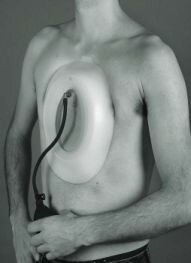|

Only available in Germany. |
This is an experimental approach which offers a non-surgical solution to pectus excavatum. It works by pulling the depressed chest forwards and, by holding this position and with treatment over a few years, to re-shape the chest. A suction cap is placed over the depressed area and a vacuum is created between it and the underlying chest wall. A patient-activated hand pump is used to reduce the pressure up to 15% below atmospheric pressure. It is suggested that the device be used for a minimum of 30 minutes, at least twice a day. It may be used for a maximum of several hours each day. Excessive negative pressure or more prolonged application can cause bruising and swelling with damage to the chest wall.
Presently, the daily treatments are recommended for 12 – 15 months. Some successes have been reported in young children. However, at present its place in the management of older people and the durability of any improvement reported is not known. This therapy is not offered in the UK, however, there is a company in Germany which sells the device. You must discuss this option with your GP prior to purchasing the device (Haeker, FM & Mayr, J. 2006). |
|

